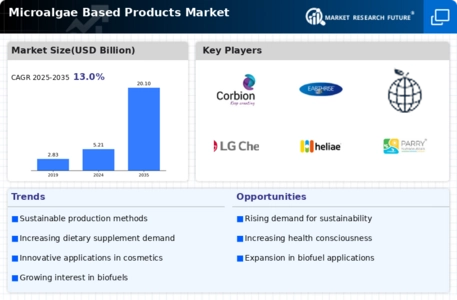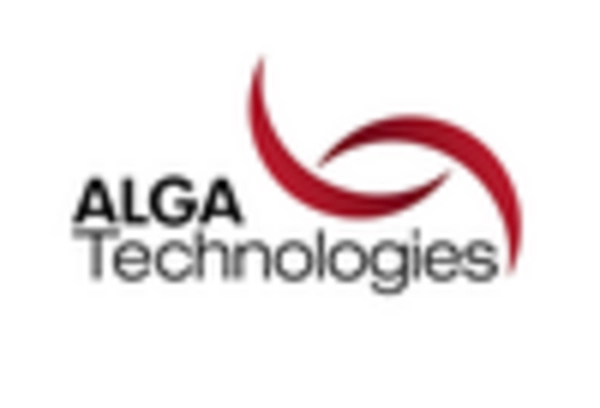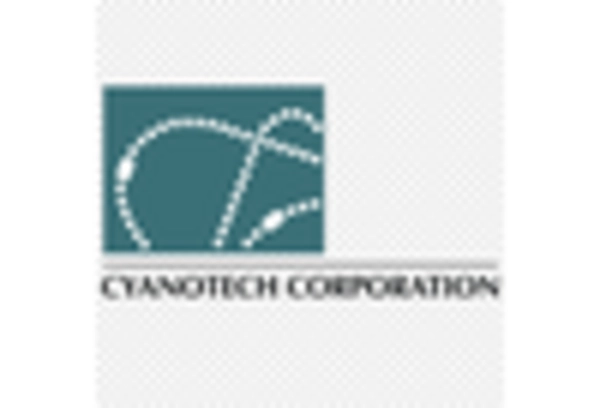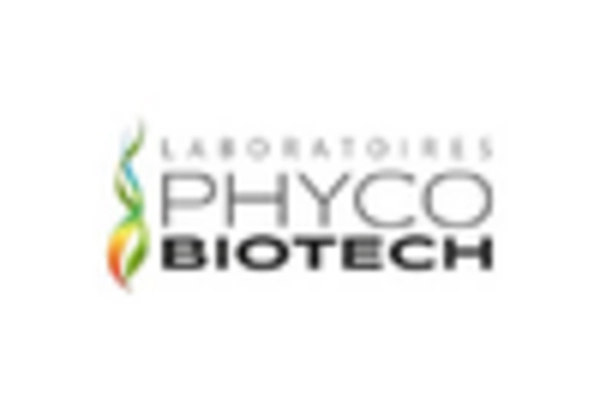Rising Health Consciousness
The increasing awareness of health and wellness among consumers appears to be a pivotal driver for the Microalgae Based Products Market. As individuals seek natural and nutrient-rich alternatives to traditional food sources, microalgae, known for their high protein content and essential fatty acids, are gaining traction. Reports indicate that the demand for plant-based proteins is projected to grow significantly, with microalgae products being at the forefront of this trend. This shift towards healthier dietary choices is likely to propel the market, as consumers are more inclined to incorporate superfoods like spirulina and chlorella into their diets. Furthermore, the potential health benefits associated with microalgae, such as improved immune function and enhanced energy levels, may further stimulate market growth.
Innovations in Product Development
Innovative product development within the Microalgae Based Products Market is driving significant interest and investment. Companies are increasingly exploring new applications for microalgae, ranging from dietary supplements to functional foods and cosmetics. The versatility of microalgae allows for the creation of diverse products that cater to various consumer preferences. For instance, the incorporation of microalgae in snack foods and beverages is becoming more prevalent, appealing to health-conscious consumers. Market data suggests that the functional food segment is expected to witness substantial growth, with microalgae-based products playing a crucial role. This innovation not only enhances product offerings but also attracts a broader consumer base, thereby contributing to the overall expansion of the market.
Growing Interest in Aquaculture Feed
The rising interest in sustainable aquaculture practices is driving demand for microalgae-based products in the aquaculture feed segment of the Microalgae Based Products Market. As the aquaculture industry seeks to reduce reliance on fishmeal and other unsustainable feed sources, microalgae are emerging as a viable alternative. Rich in essential nutrients, microalgae can enhance the growth and health of aquatic species. Market analysis suggests that the aquaculture feed segment is poised for growth, with microalgae products being increasingly incorporated into feed formulations. This trend not only supports sustainable aquaculture practices but also contributes to the overall expansion of the microalgae market, as stakeholders recognize the benefits of integrating these products into their operations.
Environmental Sustainability Initiatives
The growing emphasis on environmental sustainability is a significant driver for the Microalgae Based Products Market. As industries and consumers alike become more aware of their ecological footprints, the demand for sustainable and eco-friendly products is on the rise. Microalgae cultivation is often touted for its low resource requirements and ability to sequester carbon dioxide, making it an attractive alternative to traditional agricultural practices. Reports indicate that the microalgae market could potentially reduce greenhouse gas emissions significantly, aligning with global sustainability goals. This alignment with environmental initiatives not only enhances the appeal of microalgae products but also encourages investment and research in this sector, further propelling market growth.
Increasing Applications in Pharmaceuticals
The expanding applications of microalgae in the pharmaceutical sector are emerging as a crucial driver for the Microalgae Based Products Market. Microalgae are recognized for their bioactive compounds, which have potential therapeutic benefits. Research indicates that certain microalgae species possess anti-inflammatory, antioxidant, and antimicrobial properties, making them valuable in drug development. The pharmaceutical industry is increasingly exploring these properties for the formulation of new drugs and supplements. As the demand for natural and effective health solutions rises, microalgae-based products are likely to gain prominence in this sector. This trend not only enhances the market's growth potential but also underscores the versatility of microalgae in addressing various health challenges.

















Leave a Comment